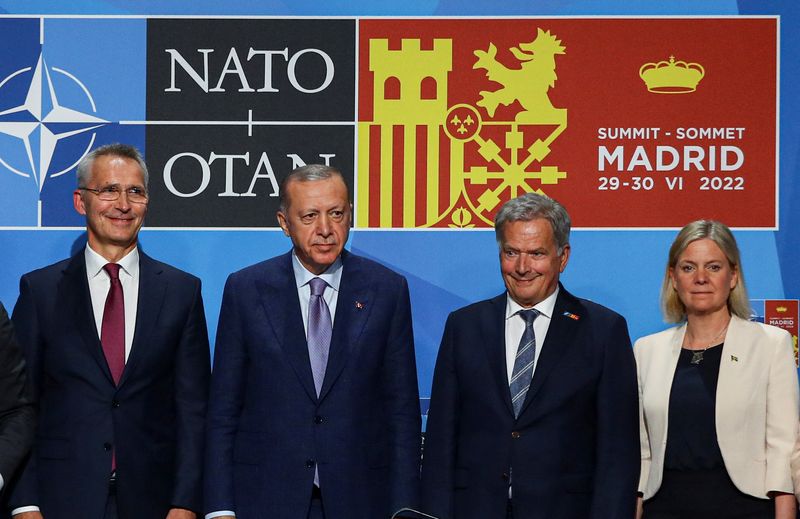Sweden, Finland on course to join NATO as Russia, China focus allies
2022.06.29 11:20

FILE PHOTO: NATO Secretary General Jens Stoltenberg, Turkish President Tayyip Erdogan, Finland’s President Sauli Niinisto and Sweden’s Prime Minister Magdalena Andersson pose after signing a document during a NATO summit in Madrid, Spain, June 28, 2022.
By Robin Emmott and Sabine Siebold
MADRID (Reuters) – Sweden and Finland on Wednesday looked set for fast-track membership of NATO after Turkey lifted a veto on them joining, while concerns about Russia and China are pushing the U.S.-led alliance to approve a broader strategy for the next decade.
After talks in Madrid, Turkish President Tayyip Edrogan on Tuesday agreed with his Finnish and Swedish counterparts a series of security measures to allow the two Nordic countries to progress in their bid to join the U.S.-led alliance.
“We will make a decision at the summit to invite Sweden and Finland to become members,” NATO Secretary-General Jens Stoltenberg said of the two countries, who overturned decades of neutrality to apply to join the alliance in mid-May.
While the agreement removed a major hurdle to the Nordic nations joining, their bid must now be approved by the member states’ parliaments, a process that could take some time.
Russia’s Feb. 24 invasion of Ukraine has given a new impetus to the North Atlantic Treaty Organisation after failures in Afghanistan and internal discord during the era of former U.S. President Donald Trump.
“We are very happy that they are to join NATO and we hope that the final decision will be today,” Polish President Andrzej Duda said as he arrived at the first formal day of the summit, which began on Tuesday evening with a dinner at Spain’s royal palace and is set to agree on NATO’s first new strategic concept – its master planning document – in a decade.
Spanish Prime Minister Pedro Sanchez, the host of the summit, told Cadena Ser radio on Wednesday that Russia will be identified as NATO’s “main threat” in the strategic concept. Russia was previously classed as a strategic partner of NATO.
The planning document will also cite China as a challenge for the first time, setting the stage for the 30 allies to plan to handle Beijing’s transformation from a benign trading partner to a fast-growing competitor from the Arctic to cyberspace.
‘MORE NATO’
Unlike Russia, whose war in Ukraine has raised serious concerns in the Baltics of an attack on NATO territory, China is not an adversary, NATO leaders said. But Stoltenberg has repeatedly called on Beijing to condemn Russia’s invasion of Ukraine, which Moscow says is a “special operation”.
The Western alliance is also set to agree that big allies such as the United States, Germany, Britain and Canada will pre-assign troops, weapons and equipment to the Baltics and intensify training exercises. NATO is also aiming to have as many as 300,000 troops ready for deployment in case of conflict, part of an enlarged NATO response force.
For NATO, Russia is achieving the opposite of what its President Vladimir Putin sought when he launched his war in Ukraine in part to counter the expansion of the NATO alliance, Western leaders say.
Both Finland, which has a 1,300 km (810 mile) border with Russia, and Sweden, home of the founder of the Nobel Peace Prize, are now set to bring well-trained militaries into the alliance, aimed at giving NATO superiority in the Baltic Sea.
“One of the most important messages from President Putin … was that he was against any further NATO enlargement,” Stoltenberg said on Tuesday evening. “He wanted less NATO. Now President Putin is getting more NATO on his borders.”








